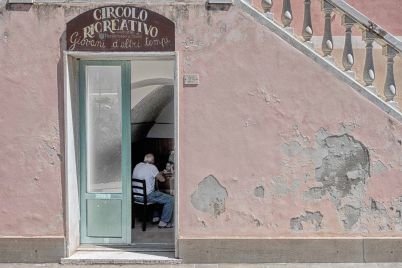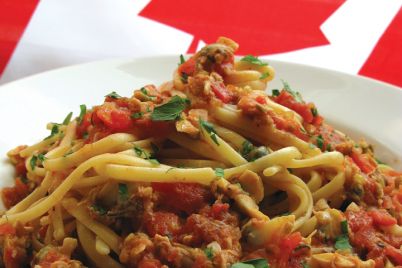Tartufo. To the connoisseur the word evokes images of a luscious and delectable, even sensual, food. “Truffle” in English sounds just as evocative. I’m not alluding to the chocolate imitation, much less to the ice cream variety but, rather, to the not so common and therefore highly-prized edible tuber – a type of fungus remotely akin to mushrooms that grows underground and which can fetch up to $4000 a kilo!
It is early October, tartufo high season, and I am in the Marche region of central Italy, in the area of Acqualagna (population 4000) – and the one place in the world where tartufo grows all year round. The town boasts not one but three yearly tartufo fairs! “Truffles all year round” is not just the town motto, but a precise description of the town’s business. I am here at the behest of the Italian Trade Commission. My goal is to uncover the mysteries of this most regal tuber and understand why it is so appealing and, well…, so expensive!
Though tartufo grows in the Marche year round, the most highly prized variety, the tuber magnatum pico or white truffle, only germinates in the fall, making this the ideal time to visit the area. My tour includes a stop at the Acqualagna Tartufi s.r.l. truffle processing plant owned by Manuela Bartolucci. Some 50 to 60 tons of truffles per year are produced in the Marche, Manuela Bartolucci explains, and two-thirds of these are bought and sold (usually at auction) in Acqualagna. The Marche are also one of only two known areas in the world where the most esteemed white truffle grows. Because truffles only grow underground and in very specific environments (usually next to tree roots in chalky soil), finding them is virtually impossible without the intervention of man’s best friend.
Outside the truffle processing plant and under the cover of darkness Giorgio, a local tartufo hunter, and his tartufo sniffer hound Lola prepare to give a demonstration. Giorgio buried a tartufo somewhere on the grounds prior to my arrival. He releases the hound, who pauses momentarily to get her bearings, then perks up her ears and points her nose forward. She eagerly starts to sniff the ground for the precious crop, tail wagging behind her.
Attempts to cultivate truffles have had only limited success. While some varieties are farmed profitably, the majority of the total yearly harvest still comes from the wild. Furthermore, farmed truffles are not nearly as tasty and therefore far less expensive than the wild variety. The best truffles, including the tuber magnatum pico, can only be gotten in the wild.
Pigs were once used to hunt for truffles. But as Giorgio explains, though swines have a more sensitive nose for truffles, they also have a tendency to eat them! And pigs don’t like to sit quietly in the passenger seat of a motor vehicle on the way to and from the truffle fields.
Truffle dogs, on the other hand, need to be trained to sniff for truffles from the time they are puppies, but virtually any type of mutt will do. A mature truffle hound can cost upwards of 20,000 euros or $30,000 – an investment easily recouped in a single season, according to Giorgio.
Some 50 metres from where we are standing, Lola is using her snout to unearth the tuber Giorgio had buried. Giorgio goes over and gives his pricey hound a treat for a job well done.
But why not demonstrate Lola’s prowess by hunting truffles in the wild? Truth is that tartufo fields are a carefully guarded professional secret. People’s livelihood depends on it, and competition for truffles is fierce, sometimes even foul. I am told that truffle dogs have been made to disappear on occasion.
Manuela emerges with a basketful of white truffles gathered the previous night. The white truffles she shows me are roundish, bumpy blobs, about the size of lemons and lighter in weight than they appear. Though they are called white, they are in fact light brown on the outside and a pale cream colour on the inside. Like caviar, it occurs to me that their purported delectableness is in sharp contrast to their appearance. Their scent is uncommon and unfamiliar – a mixture of damp forest, earth, garlic, leather, and mild gas. Still, it is not an unpleasant sensation.
Later, at Ristorante La Ginestra in Passo del Furlo, one of several restaurants in the area specializing in tartufo dishes, I get a taste of the furtive crop. Not surprisingly, tartufo is not served as a separate dish or on the side. Instead, it is sprinkled (in minute quantities!) as an ingredient on other foods for its unmistakable flavour.
My appetizer is a tartufo-flavoured egg frittata. The main pasta dish, homemade strozzapreti in a white creamy tartufo-flavoured sauce, is followed by roasted stuffed veal rump topped with tartufo shavings. As I take my first bite, the unmistakable tartufo flavour gently insinuates itself onto the back of my palate and slowly encompasses my nostrils. My taste buds are overwhelmed but not overpowered, and I begin to appreciate the appeal of the unique gustatory sensation. As I further indulge in the repast, I feel at one with bon vivants and fine gourmets the world over!
With demand so high and supply so low, tartufo is a classic example of a basic tenet of free-market economics. Despite the current global economic slowdown, truffle prices haven’t waned – to the delight of its hunters, processors and vendors. For their part, true truffle aficionados don’t seem to mind the high price of getting their hands – and their palates – on an essence that is, by all accounts, unique.
FYI
Truffles can be purchased fresh, preserved in salt and water, or as a spread. A tartufo menu in the area of Acqualagna can be enjoyed for as little as 20 euros ($30).
Guided tours of Acqualagna Tartufi s.r.l. can be organized by going online at www.acqualagnatartufi.com. Coordinates for La Ginestra Restaurant can be obtained at www.ginestrafurlo.it/indexen.htm
Acqualagna hosts the National White Truffle Fair in October and November, the Regional Superior Black Truffle Fair at the end of February, and the Regional Summer Black Truffle Fair in mid-August.
Truth is that tartufo fields are a carefully guarded professional secret. People’s livelihood depends on it, and competition for truffles is fierce, sometimes even foul.
First published in Accenti Magazine, Issue 17.



